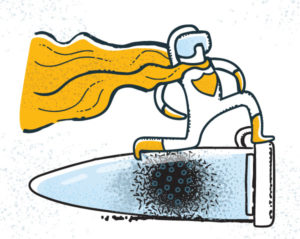
We’re all familiar with the Central Dogma of Molecular Biology: DNA is transcribed into RNA, which is translated into proteins. It’s drilled into our heads from the early days of biology classes, and it’s surprisingly useful when we start exploring in our own research projects. For example, if you’re interested in gene expression, you’ll most likely be working with RNA, specifically mRNA. Messenger RNA (mRNA) is transcribed from DNA and is used by ribosomes as a “template” for a specific protein. The total mRNA in a cell represents all of the genes that are actively being transcribed. So, if you want to know whether or not a gene is being transcribed, RNA purification is a great place to start.
When preparing your RNA samples for a downstream assay, there are several roadblocks and pitfalls that could give you quite a headache. Let’s tackle two of the most common.
Ribonucleases
RNA is notoriously susceptible to degradation. When the cell is disrupted, membrane-bound organelles release enzymes called ribonucleases (RNases) that cleave the phosphodiester bonds along the backbone of the RNA. RNases can come from anywhere, including your skin. When present in a sample, they’re annoyingly difficult to inactivate, since they’re heat-stable and don’t require cofactors.
The best way to prevent sample degradation by RNases is to practice sterile lab technique. Labs working with RNA should have a designated space that is solely dedicated to RNA-based protocols. Another one of our bloggers wrote a great post about preventing RNase nightmares (Did you know autoclaving won’t inactivate RNases?). Check it out here.
Unfortunately, even with the best technique, RNases can still end up in your sample. You can defend against this by treating your samples with RNasin® Ribonuclease Inhibitor. This inhibitor protects your samples from RNase A, B and C and helps you achieve better results in downstream applications like RT-PCR, cDNA synthesis and microarrays.
Purity and Yield
RNA can be purified from contaminants by phenol:chloroform extraction, sometimes followed by precipitation. These contaminants may include DNA, proteins or compounds used during the purification process, such as EDTA or phenol. Most downstream applications involving RNA require the sample to be free from contamination and of a precise concentration.
Purity is often assessed using absorbance ratios. Typically, the absorbance is measured at 230, 260 and 280nm. The A260/A280 ratio can indicate whether the sample is contaminated by proteins, while the A260/A230 ratio indicates the presence of compounds left over from isolation. These ratios should be approximately 1.8-2.0 and < 1.8, respectively.
Absorbance ratios, however, can sometimes give inaccurate yield estimates due to dsDNA and ssDNA contamination. RNA can be more precisely quantitated using a fluorescent dye-based method, such as the QuantiFluor® RNA System. In this type of quantitation, the dye binds only to RNA molecules and the resulting fluorescent signal can be measured to give an accurate measure of RNA concentration.
Conclusion
Even after fending off RNases and confirming purity and yield, you’ll still want to assess the integrity of the sample through ethidium bromide visualization or with an instrument such as the Agilent Bioanalyzer. This will reveal any degradation that happened during isolation. However, by using good technique and addressing the issues above, you can maximize your chances of a high-quality sample that’s ready for analysis.
To learn more about working with RNA, check out the Nucleic Acid Purification & Quantitation section of our Molecular Biology Essentials collection.
Latest posts by Jordan Villanueva (see all)
- Tackling Undrugged Proteins with the Promega Academic Access Program - March 4, 2025
- Academic Access to Cutting-Edge Tools Fuels Macular Degeneration Discovery - December 3, 2024
- Novel Promega Enzyme Tackles Biggest Challenge in DNA Forensics - November 7, 2024
